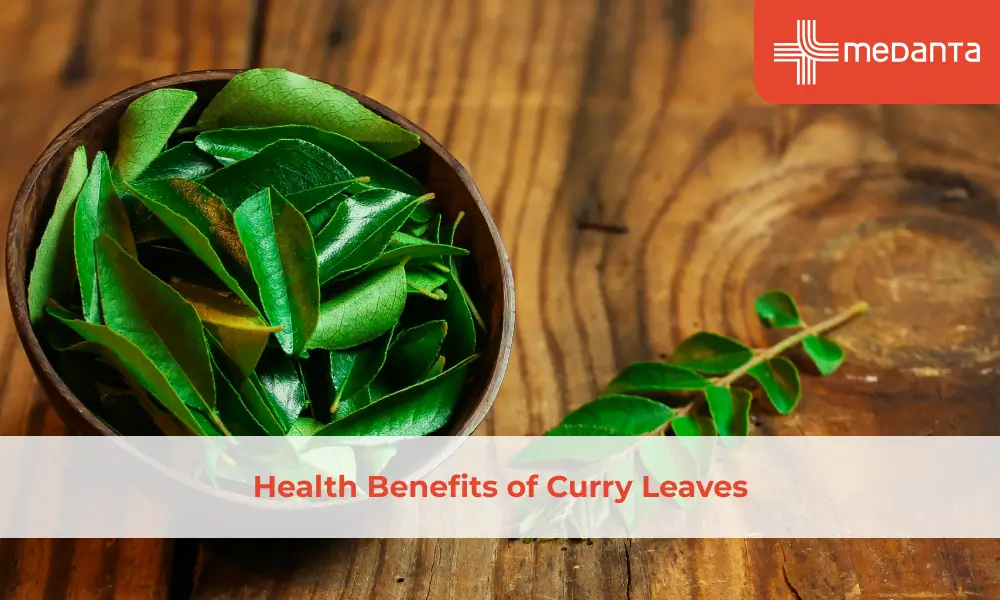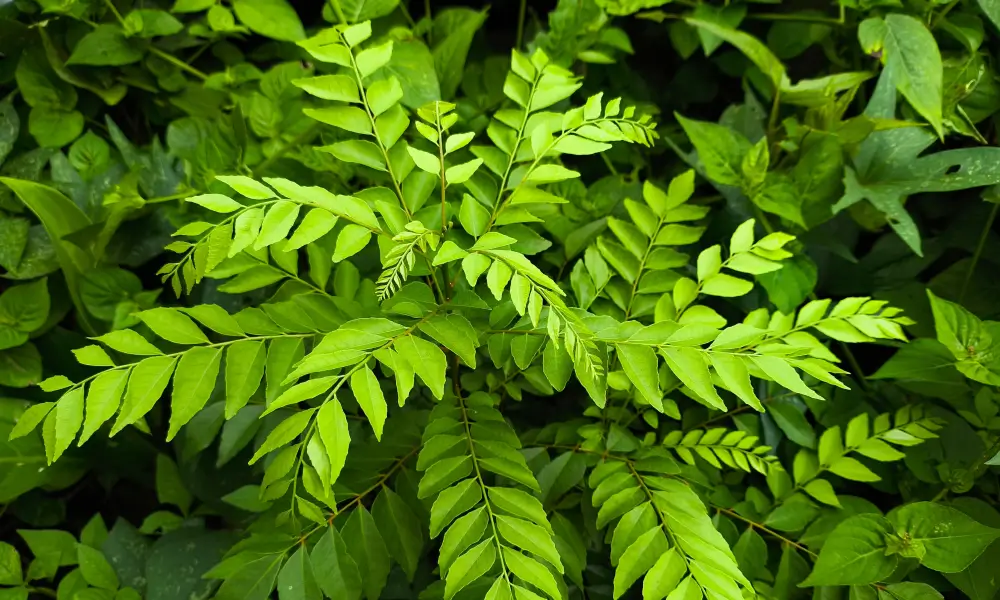Health Benefits of Curry Leaves

TABLE OF CONTENTS
Curry leaves do more than just enhance food flavour. These tiny aromatic leaves are nutritional powerhouses that contain high amounts of calcium, iron and vitamin C. Traditional medicine has valued it for centuries.
Curry leaves get their health-boosting properties from antioxidants and key nutrients such as vitamins A, B, C, and E, among minerals like phosphorus. These nutrients work in harmony to cleanse the body, help with weight control and boost heart function. The leaves' tannins and carbazole alkaloids help protect the liver. People can easily add them to their diet by using fresh leaves in cooking or taking them as supplements.
Nutritional Value of Curry Leaves
Curry leaves are a nutritional powerhouse in your kitchen finding its use in both cooking and medicine. 100 grams of these aromatic leaves have:
Calcium 830 mg
Phosphorus 57 mg
Magnesium 44 mg
They're rich in vitamins A, B, C, and E among other essential minerals like iron and potassium.
Top Health Benefits of Curry Leaves
These leaves provide amazing benefits for your health.
They help regulate cholesterol levels and support heart function. The leaves' carbazole alkaloids prevent LDL cholesterol from building up in blood vessels.
Their high iron content helps increase haemoglobin and red blood cell count, which makes them valuable to curb anaemia.
The antioxidants in curry leaves fight harmful free radicals, reduce oxidative stress and slow down cellular ageing.

Curry Leaves Uses in Daily Diet and Traditional Remedies
Ayurvedic medicine has valued curry leaves for thousands of years.
People mix them with lime juice and sugar to treat digestive problems, especially morning sickness.
The leaves release their essential oils in hot oil during the initial cooking stages. They improve the taste of South Indian soups, lentil dishes, chutneys, and samosas.
Best Ways to Consume Curry Leaves for Maximum Benefits
You can get the most benefits by chewing 5-10 fresh leaves on an empty stomach each morning to help control blood sugar. Another option is to blend 30-40 leaves with mint, cinnamon, and lemon into a metabolism-boosting tonic. Your hair care routine can include boiling curry leaves in coconut oil until crisp and using them as a scalp treatment.
Fresh vs Dried Curry Leaves: Which Is Better?
Aspect | Fresh Curry Leaves | Dried Curry Leaves |
Flavour | More aromatic and intense | Milder but still works |
Storage | Last about one week in the refrigerator | Can be stored for months in an airtight container |
Nutritional Value | Higher vitamin content | Retain most minerals and some bioactive compounds |
Convenience | Need a regular supply | Always ready in the pantry |
Usage | Perfect for tempering and fresh dishes | Better for powders and long-cooking recipes |
Complications and Precautions
Curry leaves have many benefits, but sometimes they can give you unwanted side effects. Most people tolerate them well, though some may experience allergic reactions that range from mild skin rashes to severe breathing difficulties. Chances of adverse reactions are higher if you are handling these aromatic leaves frequently. If you are pregnant, breastfeeding or taking medication ask your doctor before adding substantial amounts to your diet. People on hypertension medicine need to be extra careful since curry leaves can improve the drug's effects.
Other rare side effects include:
Mild stomach irritation or digestive discomfort include but not limited to:
Occasional bloating or gas
Interference with iron absorption
Unwanted water retention
Most issues stem from excessive consumption rather than normal culinary use. You should wash the leaves well before use, start with small amounts when trying them initially, and always follow your doctor's advice.
Conclusion
Curry leaves are nature's hidden superfood champions. These nutritional powerhouses contain rich amounts of calcium, iron, and vitamins that deserve a place in your kitchen. Without doubt, these fragrant leaves do more than just improve taste - they control cholesterol levels, shield brain function, aid digestion, and help balance blood sugar.
Ancient healing systems discovered their magic centuries ago. Ayurvedic healers used these leaves to treat various ailments. Though tiny curry leaves fight oxidative stress effectively with their antioxidant properties.
Fresh leaves deliver stronger flavours and more vitamins but dried ones keep much of their nutrition and are easier to store. Most of the time you can add curry leaves safely to your daily meals (the exception being if you take specific medicines or have certain health conditions).
FAQs
What are the main health benefits of curry leaves?
Curry leaves boost your digestive health by activating digestive enzymes and helping with stomach problems. They make insulin work better, which helps control diabetes. Your heart gets healthier because these leaves lower cholesterol and triglyceride levels. The antioxidants in curry leaves fight harmful free radicals and boost your immunity. These leaves also protect your liver from toxic damage. Your brain health improves as curry leaves might reduce the risk of brain diseases.
How can I use curry leaves in my diet?
You can start by frying curry leaves in hot oil until they turn crisp - this releases their essential oils. They taste great in curries, soups, chutneys, and dals. You can blend them with water to make a detox drink. Making curry leaf tea is easy - just boil 10-12 leaves in water. The traditional way is to chew 2-3 fresh leaves first thing in the morning. You can also dry and powder them to sprinkle on your food.
What nutrients are found in curry leaves?
These leaves pack a punch with calcium, iron and vitamin C. They're loaded with vitamins A, B, C, and E. You'll also find phosphorus and magnesium in them. The antioxidant profile has flavonoids, tannins, and carbazole alkaloids. Plant compounds like linalool, alpha-terpinene, and myrcene are also present.
Are curry leaves good for hair and skin?
Your hair follicles get nourishment from curry leaves, which makes roots stronger and stops hair loss. Vitamin A and antioxidants help prevent early greying. For best results, boil curry leaves in coconut oil until crisp and apply them to your scalp. Your skin benefits from the vitamin E in these leaves, which improves texture and fights skin problems. The antifungal properties help clear acne and keep skin healthy.
How many curry leaves should I consume daily?
According to many experts eight to ten fresh curry leaves daily can work wonders for you. Some suggest eating up to 10-15 leaves for full benefits. If you use curry leaf powder, take ¼-½ teaspoon twice daily. Capsule users should take 1-2 capsules twice daily as their doctor suggests. For tea, use 10-12 leaves. Start with small amounts to see how your body reacts.
Are there any side effects of eating curry leaves?
Eating too many curry leaves might irritate your stomach or cause heartburn. If you take diabetes medicine, watch your blood sugar levels because curry leaves make the medicine work stronger. Some people might have allergic reactions, but this rarely happens. Large amounts can lower blood pressure too much.
Is it better to use fresh or dried curry leaves?
Fresh curry leaves smell and taste stronger. They have more essential oils and vitamins. Dried leaves last longer in airtight containers. Something interesting happens when you fry dried leaves - their 1-phenylethanethiol content goes up. But dried leaves start with many fewer flavour molecules. So you'll need more dried leaves to get the same taste as fresh ones.





